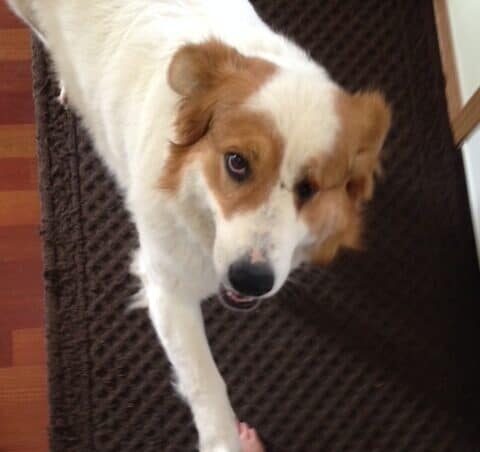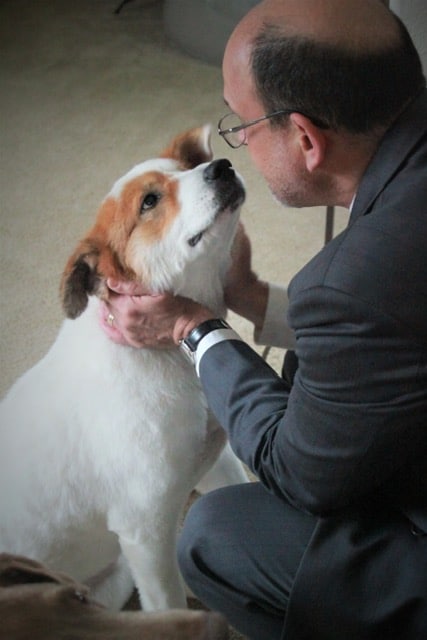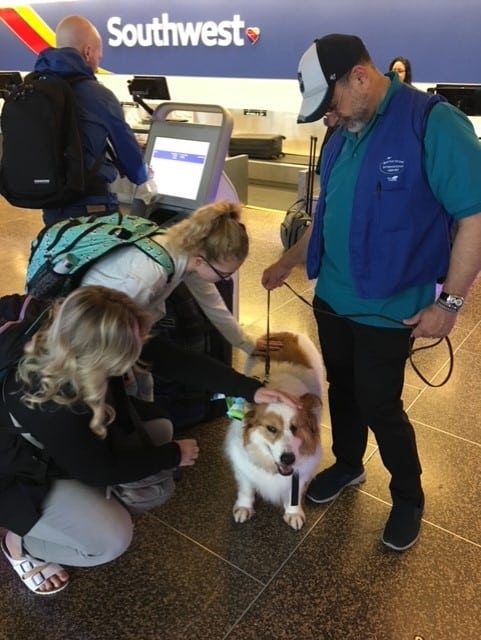



Not much is known about Sadie’s early years. What we do know is that she was a stray on the streets of Nevada. For how long, we do not know, but probably most of her life. We can deduce other details based on general observations. For example, she has several scars on her face and ears, indicating that she was attacked by dogs and/or other animals. One scar in particular traverses her nose, intersecting her left eye. The resulting infection healed on its own, but not before partially fusing her left eyelid shut. Also, she never showed any interest in dog toys – balls, stuffed animals, tug-of-war ropes, squeaky toys, etc. – none of them ever attracted her attention. If she could not eat it, she disregarded it. Most people I spoke with said this behavior indicates that she probably did not have much of a “puppy-hood.” Hers was a tough life.
Animal control picked her up, and in Nevada, strays do not last long. They are often euthanized within days of being caught. Fortunately, a rescue organization learned of her plight, literally saving her off “death row.” At that point, I found her and adopted her. I had a specific plan for Sadie. I believed she would do well as a therapy dog. Little did I know at the time just how well suited for this work Sadie was!

Sadie immediately immersed herself in the training. She was a Collie/Brittany Spaniel mix, and both breeds are known for their intelligence. In addition, Sadie had that intangible factor of empathy and intuition. She excelled in meeting the challenges required for registration.
Normally, the training period is about one year, but due to circumstances out of our control, Sadie had only six months to prepare. It did not matter. When the day of the test came, she was ready. She maxed out the scores on every one of the challenges. In fact, she scored higher than I did! (Both the dog and the handler are evaluated.)
From that point on, Sadie relished her role as a therapy dog. She worked at a nursing home and visited cancer patients in their home and in the hospital. She went to the Student Center at the University of Washington-Tacoma during mid-terms and finals, so students could decompress and relax from the stress and strain of exams. She even visited a local high school that had experienced the trauma of a shooting.
Sadie’s primary and favorite “job” was working at SeaTac International Airport, where she helped passengers – and crew – overcome the stresses of air travel. The stories of her influence and impact include a Make-a-Wish family; a mother, whose husband was deployed in the military, trying to get her three teenaged children to the funeral of her father-in-law; a woman who was so terrified of flying that she struggled to ride the escalator up to the ticket counter; a woman who overcame her lifelong fear of dogs to pet one (Sadie) for the first time in her life; and many, many children who were having meltdowns and tantrums. When Sadie arrived, the crying turned to giggles.
While most dogs are apprehensive in large groups, Sadie thrived in that environment. The more people gathered around her, the more she shined. She greeted 25 Danish exchange students at one time, all thronging her to get a chance to pet her soft, fluffy fur. Shift change for TSA turned into an opportunity for the oncoming shift to start the day with beaming smiles. Flight attendants often wanted to take selfies with her. On at least two occasions, Sadie turned toward the flight attendant and gave her a kiss on the cheek – just as the picture was taken.
One airline used us proactively. When they had flight delays, they called us and had us work the line for 10 to 15 minutes prior to their making the announcement. The strategy always worked.
Passengers were in good spirits and willingly worked with airline employees to resolve their travel issues without complaint.
Most of the therapy dogs at SeaTac stayed at an information kiosk just inside the security checkpoint, but Sadie did not like being stationary. She wanted to move around and greet people.
Each visit, we would walk through the ticket counter area, then work the line for security. Next we would go to two concourses, walking to each gate to meet and interact with passengers and crew. Sadie was the only therapy dog that was not afraid of the trams connecting the main terminal to the North and South Concourses. We rode the trams and visited those gates as well.
On one occasion, I had planned to visit two concourses in the main terminal, but Sadie “insisted” that we take the tram to the Satellites. She pulled and pulled to go toward the trams and would not walk any further toward the gates in the main terminal. Well, when a 75 lb. dog wants to go somewhere strongly enough, eventually the handler has to give in. We went to the Satellites. When I retired and moved to Florida, Sadie was aging and slowing down. She did not have the energy to work at the airport anymore. We volunteered at our local library during the summer.
Children working on crafts could come and pet Sadie when their project was done. She loved the attention, and they loved her.

Then came Nov. 20, 2023 … a day that every pet owner dreads. Sadie had been in declining health for a while. She could no longer stand up without assistance. She had stopped eating a few days before. Her stools came out as a greasy liquid. Though we did not want to acknowledge it, we knew it was “time.”
I made the appointment. I placed her in our car, and my wife and I drove her, one last time, to her veterinarian. We led her into the clinic. Sadie had always enjoyed going to the vet. She would often walk from workstation to workstation, greeting the techs. But this time was different. For the first time ever, Sadie was afraid. She tried to leave the exam room, then, failing that, buried her head under my arm. Eventually, she calmed down.
The doctor came in, her eyes filled with tears just as ours were. She administered the first injection, and Sadie drifted off to sleep. Then came the second syringe, … and one of the sweetest, most gentle spirits ever to grace this earth departed.
The title of this tribute encapsulates the twofold purpose for sharing this story. First, despite the sad ending, I hope you, the reader, find it heart-warming.
Second, I hope someone will read this article and think, “Maybe my dog (or cat) could work as a therapy animal.” There are many organizations that provide training and registration for therapy animals. We worked with Pet Partners (petpartners.org), an international therapy animal registration organization. They are widely regarded as one of, if not THE, most rigorous therapy animal organizations. Their standards are very high.
Sadie will live on in the memories of those of us who were impacted by her. If even one person is inspired to register their dog as a therapy animal, then Sadie’s legacy will continue, blessing even more people than the hundreds she touched in her decade of service.